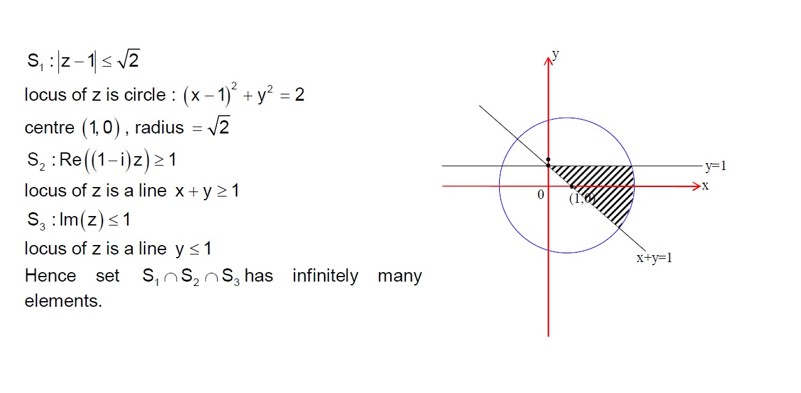Complex Numbers and Quadratic Equations
Get insights from 193 questions on Complex Numbers and Quadratic Equations, answered by students, alumni, and experts. You may also ask and answer any question you like about Complex Numbers and Quadratic Equations
Follow Ask QuestionQuestions
Discussions
Active Users
Followers
New answer posted
a month agoContributor-Level 10
For the quadratic equation (k+1)tan²x - √2λ tanx + (k-1) = 0, the roots are tanα and tanβ.
Sum of roots: tanα + tanβ = √2λ / (k+1).
Product of roots: tanα tanβ = (k-1) / (k+1).
tan (α + β) = (tanα + tanβ) / (1 - tanα tanβ)
tan (α + β) = [√2λ / (k+1)] / [1 - (k-1)/ (k+1)]
tan (α + β) = [√2λ / (k+1)] / [ (k+1 - k + 1)/ (k+1)] = (√2λ) / 2 = λ/√2.
Given tan² (α+β) = 50.
(λ/√2)² = 50
λ²/2 = 50 ⇒ λ² = 100 ⇒ λ = ±10.
New answer posted
a month agoContributor-Level 10
Given Re (z-1)/ (2z+i) = 1, where z = x + iy.
(z-1)/ (2z+i) = [ (x-1) + iy] / [2x + I (2y+1)]
To rationalize, multiply the numerator and denominator by the conjugate of the denominator [2x - I (2y+1)].
Numerator = [ (x-1) + iy] * [2x - I (2y+1)] = 2x (x-1) - I (x-1) (2y+1) + i2xy + y (2y+1)
Real part of the numerator = 2x (x-1) + y (2y+1).
Denominator = (2x)² + (2y+1)².
Re (z-1)/ (2z+i) = [2x (x-1) + y (2y+1)] / [ (2x)² + (2y+1)²] = 1.
2x² - 2x + 2y² + y = 4x² + 4y² + 4y + 1.
0 = 2x² + 2y² + 2x + 3y + 1.
So, 2x² + 2y² + 2x + 3y + 1 = 0.
New answer posted
a month agoContributor-Level 9
log? /? [ (|z|+11)/ (|z|-1)²] < 2
(|z|+11)/ (|z|-1)² > (1/2)²
(|z|+11)/ (|z|-1)² > 1/4
⇒ 4|z| + 44 > |z|² - 2|z| + 1
⇒ |z|² - 6|z| - 43 < 0
⇒ |z| - 7 ≤ 0
∴ |z|max = 7
New answer posted
a month agoContributor-Level 10
The inequality is experience ( (|z|+3) (|z|-1) / (|z|+1) * log?2 ) ≥ log√? 16.
The right side is log? (1/2) 16 = log? (2? ¹) 2? = (4/-1)log?2 = -4. This seems incorrect.
Let's assume the base of the log on the right is √2. log√? 16 = log? (1/2) 2? = 2 * log?2? = 8.
The inequality becomes: 2^ (|z|+3) (|z|-1) / (|z|+1) ≥ 8 = 2³.
So, (|z|+3) (|z|-1) / (|z|+1) ≥ 3.
Let |z| = t. (t+3) (t-1) / (t+1) ≥ 3
t² + 2t - 3 ≥ 3t + 3
t² - t - 6 ≥ 0
(t-3) (t+2) ≥ 0
Since t = |z| ≥ 0, we must have t-3 ≥ 0.
So, t ≥ 3, which means |z| ≥ 3.
The minimum value of |z| is 3.
New question posted
a month agoNew answer posted
a month agoContributor-Level 10
I = ∫[0 to 10] [sin(2πx)] / e^(x-[x]) dx.
The period of the integrand involves [sin(2πx)] which depends on the sign of sin(2πx) and {x} = x - [x], which has a period of 1.
Let f(x) = [sin(2πx)] / e^{x}.
The integral is ∫[0 to 10] f(x) dx = 10 * ∫[0 to 1] f(x) dx due to the periodicity of {x} and the integer period of sin(2πx).
In the interval (0, 1/2), sin(2πx) is between 0 and 1, so [sin(2πx)] = 0.
In the interval (1/2, 1), sin(2πx) is between -1 and 0, so [sin(2πx)] = -1.
At x=0, 1/2, 1, the value is 0.
So, ∫[0 to 1] f(x) dx = ∫[0 to 1/2] 0 dx + ∫[1/2 to 1] -1/e^x dx
= 0 + [-e^(-x) * (-1)] from 1/2 to 1 = [e^(-x)] from 1
New answer posted
a month agoContributor-Level 10
The general equation of a circle is given by:
az z? + α? z + αz? + d = 0
This can be rewritten as:
z? + (α? /a)z + (α/a)z? + d/a = 0
From this, we can identify the centre and radius:
Centre = -α/a
Radius = √ (|-α/a|² - d/a)
For a real circle to exist, the term under the square root must be non-negative:
|-α/a|² - d/a ≥ 0
|α|²/|a|² - d/a ≥ 0
|α|² - ad ≥ 0, where a ∈ R - {0}.
New answer posted
a month agoContributor-Level 10
∴ x² = |x|² = t let
9t² - 18t + 5 = 0
(3t - 1) (3t - 5) = 0
|x| = 1/3, 5/3
Product of roots = (1/3) (-1/3) (5/3) (-5/3) = 25/81
Taking an Exam? Selecting a College?
Get authentic answers from experts, students and alumni that you won't find anywhere else
Sign Up on ShikshaOn Shiksha, get access to
- 65k Colleges
- 1.2k Exams
- 687k Reviews
- 1800k Answers

